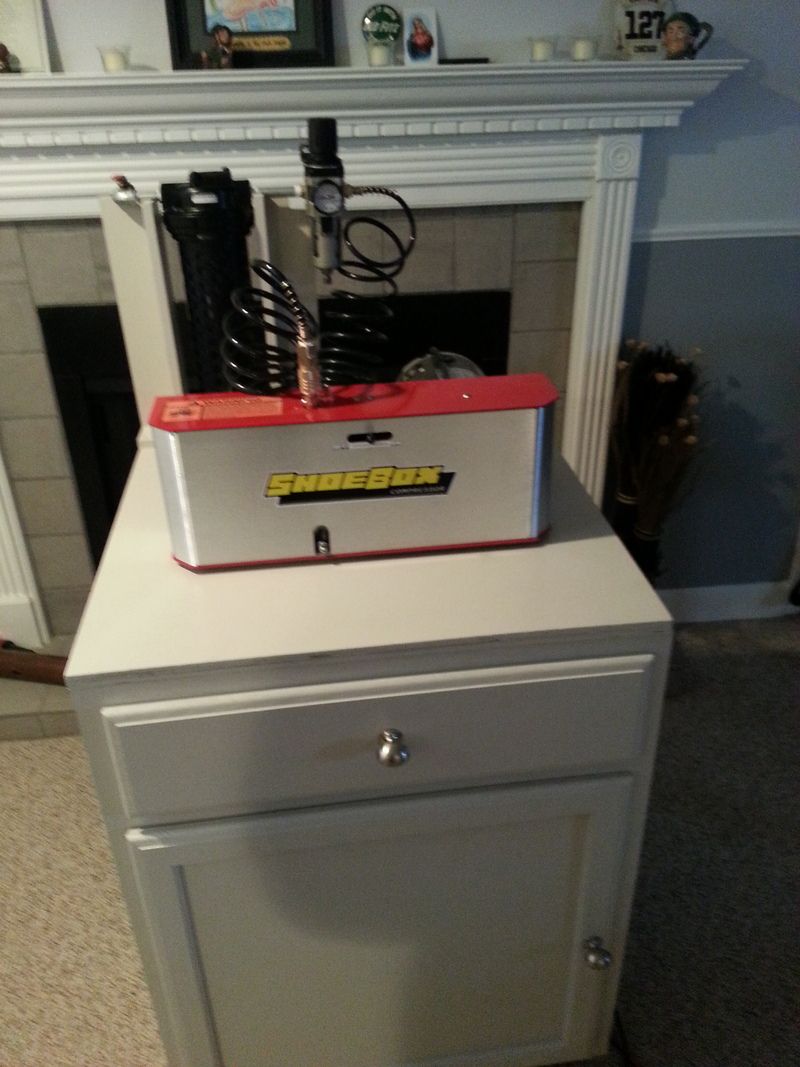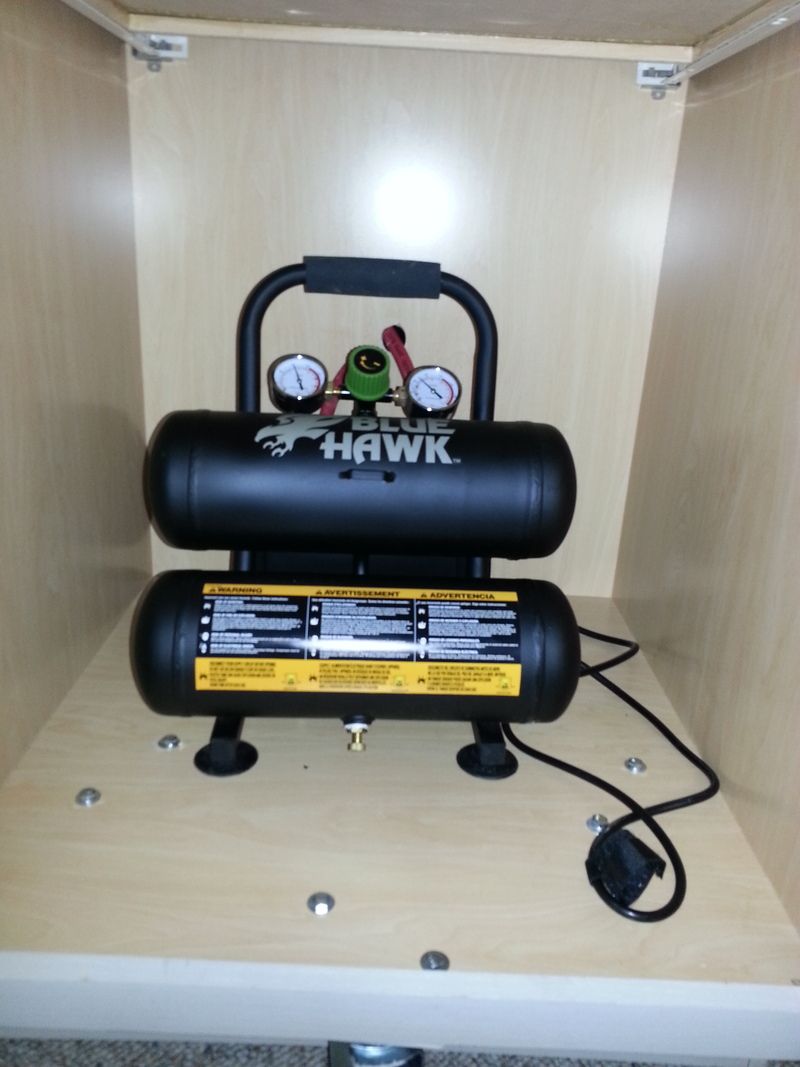I read the post below in the "General Airgunning" section about building a custom air gun carrier/caddy. It got me to thinking about a previous desire I had to build a "custom" project. Whenever I needed to charge my airguns/tanks I would have to gather the different components together along with hoses, filters, power cords, etc...then when completed, I would have to break it all down and stow it. It was both time consuming and frustrating to say the least.
So.......I sat down to design and draw up plans for a "Custom" Air Charging Station...a wood cabinet to house and centralize all these various components and accessories.
Unfortunately, It evolved into a major project and I found that the final material cost and required labor was excessive, especially for a cabinet that might not have an "alternate use" should I decide in the future to pursue a different hobby (you never know).
I was initially disappointed, but I researched other options and invoking the K.I.S.S. principle I decided that instead of building a wood cabinet/enclosure I would just settle for a basic, sturdy, adjustable shelving unit made of metal and generally found at most of the big box stores.
I took measurements on all my equipment and decided that a simple open shelf unit 36"W x 18"D x 72"H with 4 shelves would be ideal. I also opted to install optional casters so I could easily move the unit around and allow easy access to the components if needed.
A five shelf unit with the casters run me about $80 (with my 10% military discount). I was looking at about 3x that amount for my wood design plus the labor!
Pictures below show my complete setup. The oil-less compressor on the bottom shelf has wheels and can be easily rolled off the shelf and transported to another location for other air uses if necessary. The second shelf holds the rest of the components; a small refrigerated air dryer with attached Filter/Regulator assemblies, a Wilkerson desiccant dryer, a Shoebox Freedom 8 and a Joe B. Tiger Shark HP air tank.
The remaining upper two shelves I use for storing spare parts, shooting supplies, and misc airgun related items.
A side benefit of this "Open" wire shelf design is that it allows for easy cord, tubing and hose routing (no holes to cut). It also allows any additional items to be easily mounted/unmounted. I just recently added the Diablo filter and decided for now to just hang it off the shelf using a couple of cord hangers.






This is not a "Custom Built" unit, and I fully understand the enjoyment and pride associated with designing and building a project from the ground up, but this time a simple, relatively inexpensive and extremely mobile setup, has worked better for me and sure made for a more organized and controlled operation when recharging my tanks. In this case, the K.I.S.S. principle worked.
Sometimes the simpler, easier or least expensive path will give you the same or better results! That's probably the reason I liked Lawrence's simple Airgun/Equipment Caddy and the reason I decided to write and pass this on about my experience.
LarryK
So.......I sat down to design and draw up plans for a "Custom" Air Charging Station...a wood cabinet to house and centralize all these various components and accessories.
Unfortunately, It evolved into a major project and I found that the final material cost and required labor was excessive, especially for a cabinet that might not have an "alternate use" should I decide in the future to pursue a different hobby (you never know).
I was initially disappointed, but I researched other options and invoking the K.I.S.S. principle I decided that instead of building a wood cabinet/enclosure I would just settle for a basic, sturdy, adjustable shelving unit made of metal and generally found at most of the big box stores.
I took measurements on all my equipment and decided that a simple open shelf unit 36"W x 18"D x 72"H with 4 shelves would be ideal. I also opted to install optional casters so I could easily move the unit around and allow easy access to the components if needed.
A five shelf unit with the casters run me about $80 (with my 10% military discount). I was looking at about 3x that amount for my wood design plus the labor!
Pictures below show my complete setup. The oil-less compressor on the bottom shelf has wheels and can be easily rolled off the shelf and transported to another location for other air uses if necessary. The second shelf holds the rest of the components; a small refrigerated air dryer with attached Filter/Regulator assemblies, a Wilkerson desiccant dryer, a Shoebox Freedom 8 and a Joe B. Tiger Shark HP air tank.
The remaining upper two shelves I use for storing spare parts, shooting supplies, and misc airgun related items.
A side benefit of this "Open" wire shelf design is that it allows for easy cord, tubing and hose routing (no holes to cut). It also allows any additional items to be easily mounted/unmounted. I just recently added the Diablo filter and decided for now to just hang it off the shelf using a couple of cord hangers.






This is not a "Custom Built" unit, and I fully understand the enjoyment and pride associated with designing and building a project from the ground up, but this time a simple, relatively inexpensive and extremely mobile setup, has worked better for me and sure made for a more organized and controlled operation when recharging my tanks. In this case, the K.I.S.S. principle worked.
Sometimes the simpler, easier or least expensive path will give you the same or better results! That's probably the reason I liked Lawrence's simple Airgun/Equipment Caddy and the reason I decided to write and pass this on about my experience.
LarryK


